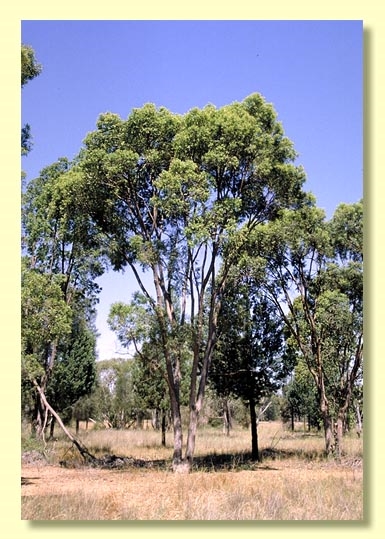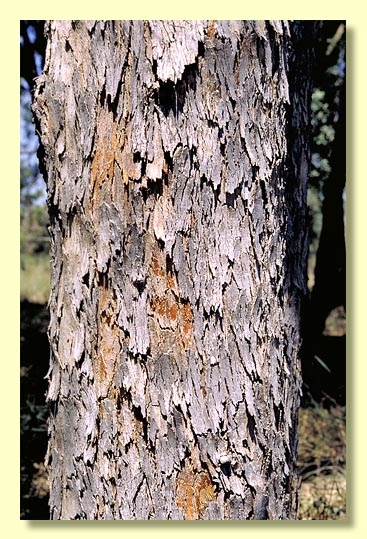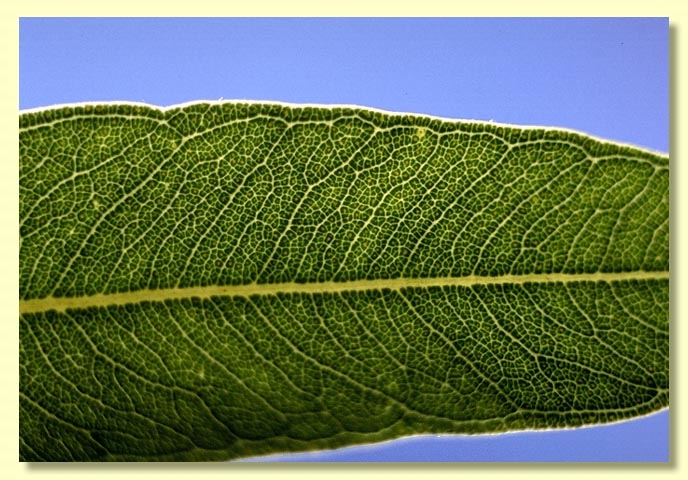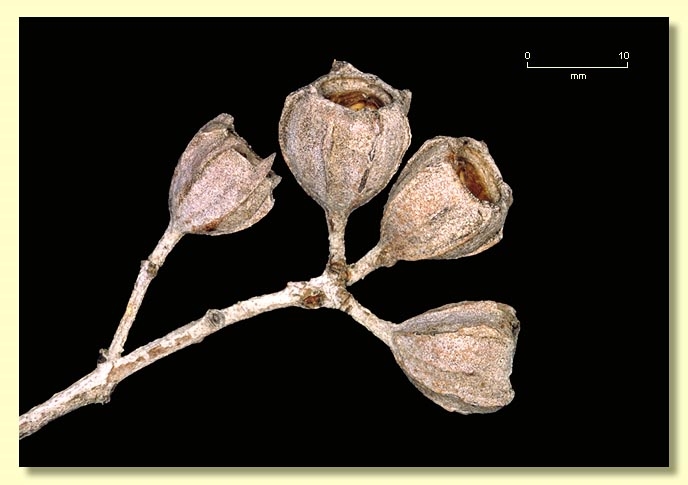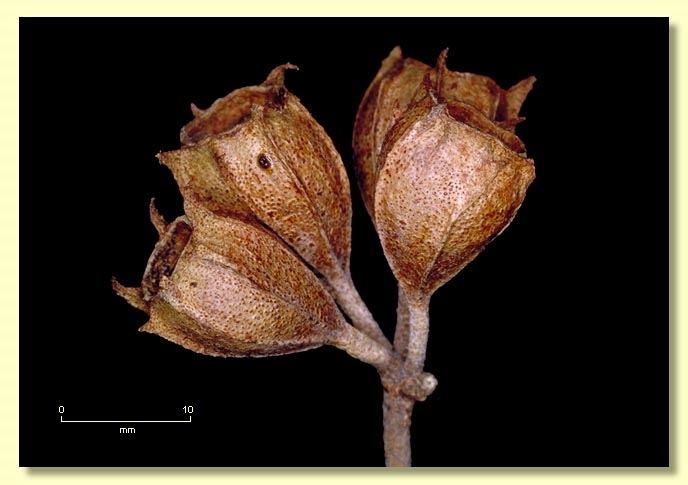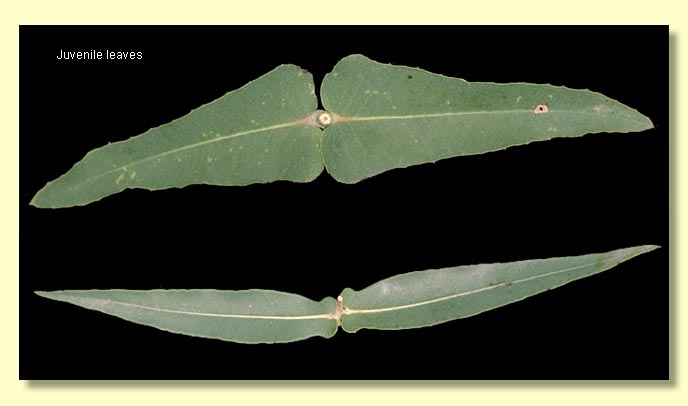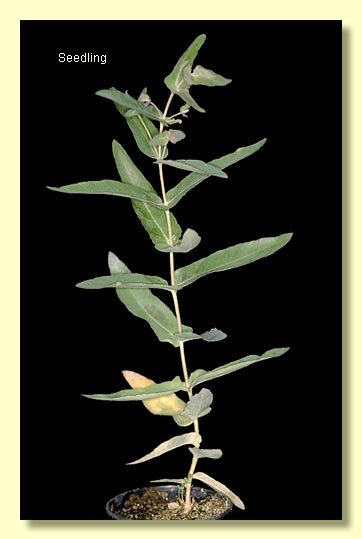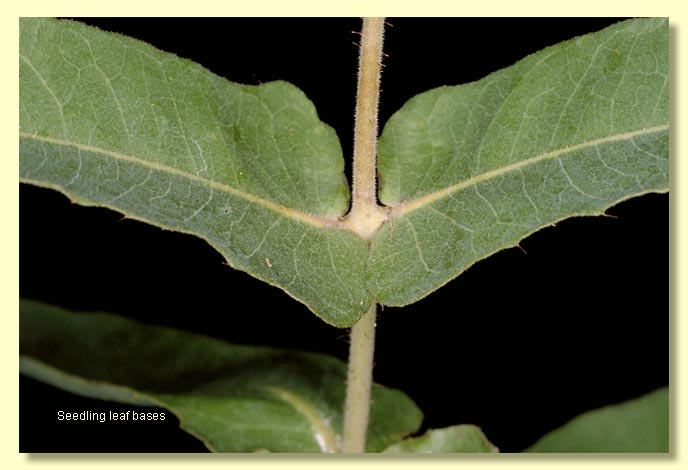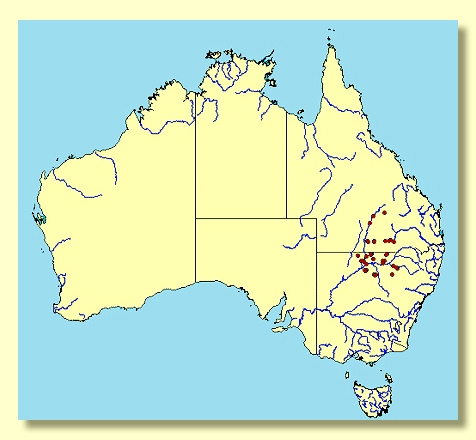Angophora
Euclid - Online edition
Angophora melanoxylon
A. intermedia var. melanoxylon (R.T.Baker) Maiden & Betche, Census New South Wales Pl. 145 (1916); Eucalyptus melana Brooker, Austral. Sys. Bot. 13: 137 (2000). T: Coolabah, NSW, Feb. 1900, W.Bäuerlen s.n.; lecto: NSW, fide G.J.Leach, Telopea 2: 771 (1986).
Small multistemmed shrub to medium-sized tree to 15 m tall. Forming a lignotuber.
Bark rough to the small branches, fibrous, grey to grey-brown.
Young branchlets with dense white short multicellular simple hairs and much longer sparse brown setae (bristle-glands); glands (or ducts) sometimes present in the pith but only seen just below the nodes on young branchlets.
Juvenile growth (coppice or field seedlings to 50 cm): stem rounded in cross-section, pubescent; juvenile leaves opposite, sessile, lanceolate, 4.5–10 cm long, 1.2–2.5 cm wide, base amplexicaul, sometimes truncate and wider than the lamina, margin entire or finely toothed, apex acute, dull, grey-green to blue-grey to green, pubescent becoming glabrous with age.
Adult leaves opposite, sessile or with petioles 0–1 cm long; blade narrowly lanceolate to linear or sometimes narrowly elliptical, 3–9 cm long, 0.6–2.2 cm wide, flat, base amplexicaul (sessile) or tapering to petiole or lobed (sometimes the lobes wider than the lamina) or rounded, margin entire, apex acute, discolorous, dull grey-green to green, penniveined, densely to very densely reticulate, intramarginal vein present, oil glands small island or obscure.
Inflorescence terminal compound, peduncles 0.6–2.3 cm long, buds 3 or 7 per umbel, pedicellate (pedicels 0.5–0.8 cm long). Mature buds globular (0.4–0.6 cm long, 0.4–0.7 cm wide), hypanthium pubescent, longitudinally ribbed, petals white with a green keel, stamens inflexed, anthers oblong, versatile, dehiscing by longitudinal slits (non-confluent), style long, stigma blunt, mop-like, locules 3 or 4, the placentae each with 5 vertical ovule rows. Flowers white or creamy white.
Fruit pedicellate (pedicels 0.3–0.9 cm long), cup-shaped to cylindrical to barrel-shaped, 0.8–1.3 cm long, 0.7–1.1 cm wide, longitudinally ribbed, disc descending, valves 3 or 4, enclosed.
Seeds reddish brown to brown, 4–7 mm long, flattened-ellipsoidal, dorsal surface smooth, hilum ventral.
Cultivated seedlings (measured at ca node 10): cotyledons reniform to orbicular; stems rounded in cross-section, scabrid with bristle-glands and hairs; leaves opposite, sessile (rarely subsessile), lanceolate to oblong, 3–9 cm long, 0.8–3 cm wide, amplexicaul, margin entire or irregular, apex pointed, discolorous, green to grey-green, scabrid.
Flowering has been recorded in December.
Angophora melanoxylon is a small to medium-sized rough-barked tree, notable in the genus for the dark heartwood. It is widely distributed in drier areas of northern New South Wales, from Pilliga west towards Bourke, and north into southern Queensland, west to Cunnamulla and north to Augathella and east to about St George.
The mature crown of A. melanoxylon is often a mixture petiolate adult leaves and sessile juvenile leaves, often with amplexicaul to auriculate leaf bases.
Throughout its distribution A. melanoxylon should be confused with no other species.
MORE ABOUT ANGOPHORA

